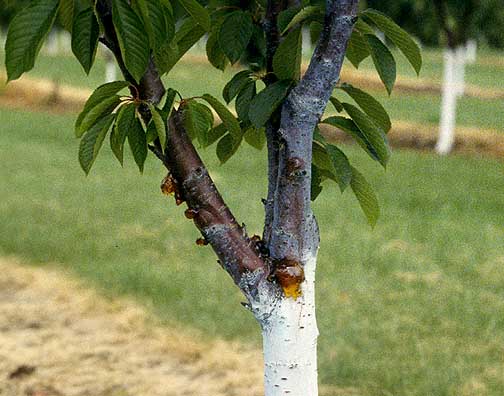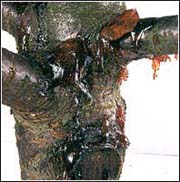Cantankerous Cherry Trees
Have you noticed your flowering cherry tree or other fruit trees with a ‘gummy’ paste hanging from their branches? This is a common problem and if you look closer you will see that it occurs from a wound. Wounding can occur by pruning, stakes rubbing or storm damage. A more common cause of this injury however is Cicada’s. They may be the sound of summer but they can cause big damage to any soft wooded plants, especially Prunus and Camellias. If you look at the wound you will see a herringbone pattern which is the Cicada scratching the bark.
It is best to prune out these damaged branches unless it really affects the shape or they are only superficial. This can be difficult to do on larger trees but it is worthwhile for smaller trees to get them off to the best start. In many cases the wound will heal over but if it is too deep the branches can eventually snap in high wind.
It becomes more of an issue if they get infected will a bacterical canker.
How do I recognise bacterial canker?
The bacteria Pseudomonas syringae causes this disease which starts in spring. The infection occurs through leaf scars and wounds. These give rise to small cankers in which the bacteria grow. Cankers are splits in the bark which start at the infected bud and spread upwards and can quickly enlarge. Generally a great deal of gum is exuded from the cankers.


Other Symptoms:
Look for cankers if any of the following occur:
- Brown spots develop on leaves in spring. These spots fall out giving a distinctive 'shot hole' appearance.
- Leaves on cankered stems are yellow, then rapidly shrivel and die.
- Young shoots or flowering shoots die back or wither in spring and early summer.
Control
Pruning to prevent the spread of the bacteria should be carried out during summer in dry weather, as infection of the branches occurs in autumn and winter. This also reduces the risk of secondary infection via the pruning wounds. If pruning canker-affected branches, wipe you cutters with disinfectant between each cut.
Spray the foliage, branches and trunk thoroughly with copper oxycloride. Three applications of the fungicide are best. The first as the leaves start to colour in autumn. (This will be taken back into the tree). The second should be done when the leaves have fallen but before the buds close for the winter. The third spray should be done in early spring as the buds start to swell and open. A fourth spray when all the leaves have hardened in summer can be beneficial as well. Don’t spray the soft, spring growth as it can damage the tree.
Gather up and destroy leaves in autumn by burning, burying or through composting.
Will my tree always get infected?
Trees in good condition usually aren’t infected. But when they are stressed, wounded or are old, they can become vulnerable. Don’t over-feed the trees with nitrogen rich fertilisers. Soft growth, especially in late summer, is particularly vulnerable to attack.
Unfortunately trees can become infected in a very short time span, especially if you or a neighbour has an infected tree. Just keep an eye on them, prevention is easier than curing.